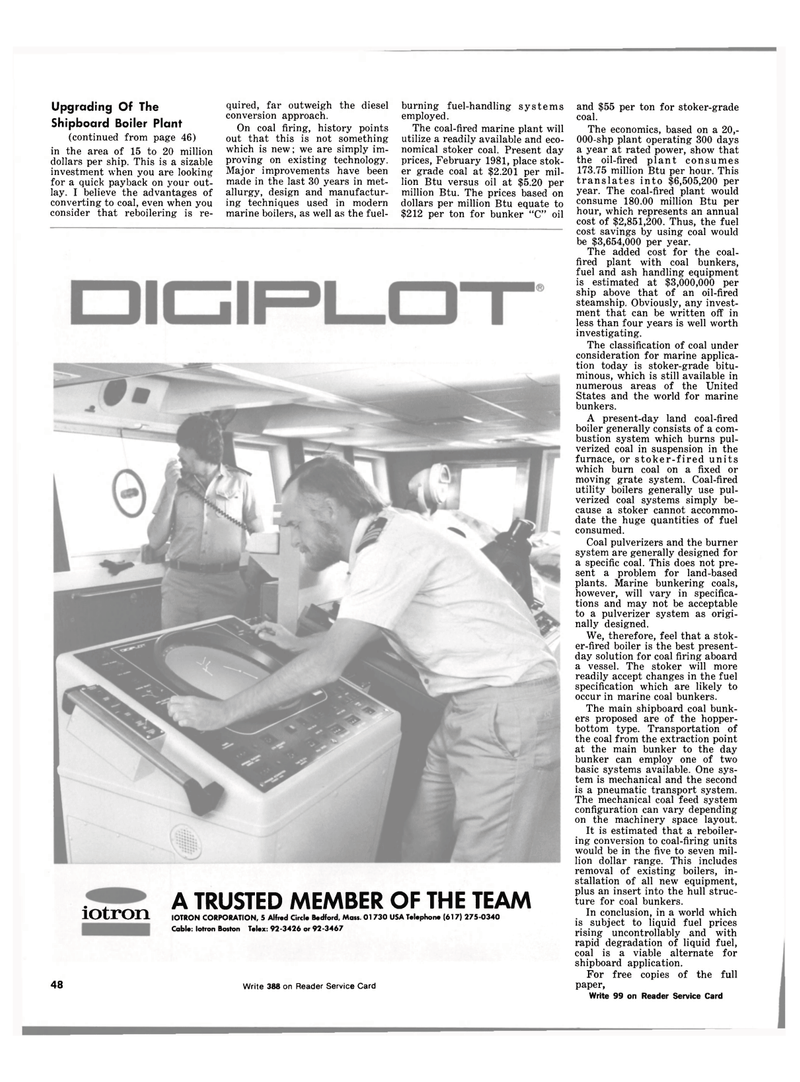
Page 50: of Maritime Reporter Magazine (November 1981)
Read this page in Pdf, Flash or Html5 edition of November 1981 Maritime Reporter Magazine
Upgrading Of The
Shipboard Boiler Plant (continued from page 46) in the area of 15 to 20 million dollars per ship. This is a sizable investment when you are looking for a quick payback on your out- lay. I believe the advantages of converting to coal, even when you consider that reboilering is re- quired, far outweigh the diesel conversion approach.
On coal firing, history points out that this is not something which is new; we are simply im- proving on existing technology.
Major improvements have been made in the last 30 years in met- allurgy, design and manufactur- ing techniques used in modern marine boilers, as well as the fuel- burning fuel-handling systems employed.
The coal-fired marine plant will utilize a readily available and eco- nomical stoker coal. Present day prices, February 1981, place stok- er grade coal at $2,201 per mil- lion Btu versus oil at $5.20 per million Btu. The prices based on dollars per million Btu equate to $212 per ton for bunker "C" oil and $55 per ton for stoker-grade coal.
The economics, based on a 20,- 000-shp plant operating 300 days a year at rated power, show that the oil-fired plant consumes 173.75 million Btu per hour. This translates into $6,505,200 per year. The coal-fired plant would consume 180.00 million Btu per hour, which represents an annual cost of $2,851,200. Thus, the fuel cost savings by using coal would be $3,654,000 per year.
The added cost for the coal- fired plant with coal bunkers, fuel and ash handling equipment is estimated at $3,000,000 per ship above that of an oil-fired steamship. Obviously, any invest- ment that can be written off in less than four years is well worth investigating.
The classification of coal under consideration for marine applica- tion today is stoker-grade bitu- minous, which is still available in numerous areas of the United
States and the world for marine bunkers.
A present-day land coal-fired boiler generally consists of a com- bustion system which burns pul- verized coal in suspension in the furnace, or stoker-fired units which burn coal on a fixed or moving grate system. Coal-fired utility boilers generally use pul- verized coal systems simply be- cause a stoker cannot accommo- date the huge quantities of fuel consumed.
Coal pulverizers and the burner system are generally designed for a specific coal. This does not pre- sent a problem for land-based plants. Marine bunkering coals, however, will vary in specifica- tions and may not be acceptable to a pulverizer system as origi- nally designed.
We, therefore, feel that a stok- er-fired boiler is the best present- day solution for coal firing aboard a vessel. The stoker will more readily accept changes in the fuel specification which are likely to occur in marine coal bunkers.
The main shipboard coal bunk- ers proposed are of the hopper- bottom type. Transportation of the coal from the extraction point at the main bunker to the day bunker can employ one of two basic systems available. One sys- tem is mechanical and the second is a pneumatic transport system.
The mechanical coal feed system configuration can vary depending on the machinery space layout.
It is estimated that a reboiler- ing conversion to coal-firing units would be in the five to seven mil- lion dollar range. This includes removal of existing boilers, in- stallation of all new equipment, plus an insert into the hull struc- ture for coal bunkers.
In conclusion, in a world which is subject to liquid fuel prices rising uncontrollably and with rapid degradation of liquid fuel, coal is a viable alternate for shipboard application.
For free copies of the full paper,
Write 99 on Reader Service Card
Iotron A TRUSTED MEMBER OF THE TEAM IOTRON CORPORATION, 5 Alfred Circle Bedford, Mass. 01 730 USA Telephone (617) 275-0340
Cable: Iotron Boston Telex: 92-3426 or 92-3467 48 Write 388 on Reader Service Card

 49
49

 51
51
